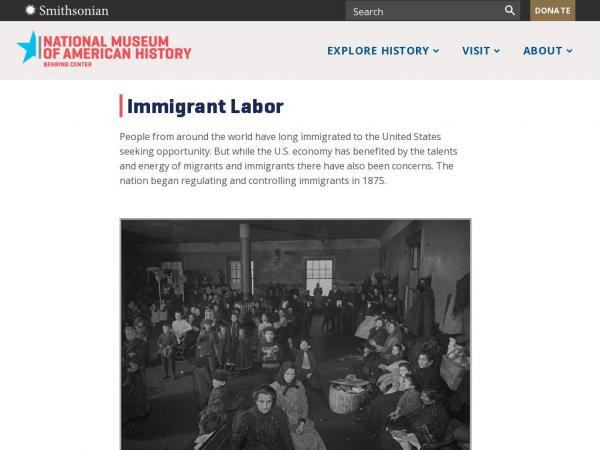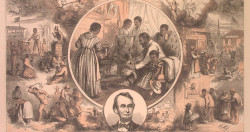Jill Stedman's collections
Effects of innovation during the 1920s
<p>This learning lab will help you to evaluate the ways in which the innovations that came about during the roaring twenties altered American life. Moreover, you will consider how these innovations sometimes had unintended consequences for more marginalized communities, specifically immigrants. </p>
<p>#SAAMteach</p>
 Jill Stedman
Jill Stedman
10
Freedom Fulfilled...Freedom Denied: Evaluating the Effects Reconstruction
<p><strong>Georgia Standards of Excellence:</strong></p>
<p><strong>SS8H6 Analyze the impact of Reconstruction on Georgia.<br></strong>a. <u>Explain the roles </u>of the 13th, 14th, and <u>15th Amendments</u> in Reconstruction.</p>
<p>c. Compare and contrast the goals and outcomes of the <u>Freedmen’s Bureau</u> and the <u>Ku Klux Klan</u>.<br>e. <u>Give examples of goods and services produced </u>during the Reconstruction Era, including the use of <u>sharecropping </u>and tenant farming.</p>
<p><strong>Essential Question: </strong>For African Americans, did the Reconstruction Era live up to its promise?</p>
<p><strong>Tasks:</strong> </p>
<p><strong>Step 1: </strong>Source analysis expert groups</p>
<p>Students will be organized into one of two groups. One group will explore the economic effects of Reconstruction on the lives of African Americans; the second group will explore the political effects. Students will study their assigned sources and then record their observations and analysis in the See / Say, Mean, Matter graphic organizer.</p>
<p>As a whole class, we will study and analyze documents 1, 6, & 7.</p>
<p>Economic Effects Team: This group will study and analyze documents 2, 3, 4, 5, 14, 15, & 16.</p>
<p>Political Effects Teams:This group will study and analyze documents 8, 9, 10, 11, 12 & 13.</p>
<p><strong>Step 2: </strong>Students will be reorganized into two new teams, with members from both the economic and political expert groups. Team members will share the knowledge they gained from their expert groups to complete the Cross-Impact Matrix (CIM) organizer. </p>
<p></p>
 Jill Stedman
Jill Stedman
21
Seeking equality: A brief history of the American women's fight for political rights
<p>This learning lab provides the preface and context for an in-class SAAM presentation on the ideology of republican motherhood as it influenced women during the years 1770 to 1920. This lesson seeks to answer two questions:
</p>
<ul><li>To what extent did American women embrace the ideology presented by republican motherhood?
</li><li>In what ways and to what extent did women find the ideology to be confining, and thus, challenge it?
</li></ul><p><strong>Preparing for the lesson:</strong>
</p>
<p>The night before the first lesson, students will:
</p>
<ul><li>Study the document Women’s Suffrage Postcard and respond to the Claim-Support-Question activity built into the document. Look for the paper clip icon in the upper left hand corner.
</li><li>Read the article: How women’s history and civil rights came to the Smithsonian; be sure to read my annotation attached via the paper clip icon.
</li><li>Watch Dr. Berkin’s short presentation on republican motherhood; craft your own definition of republican motherhood and post it in the text entry box under the paper clip icon.
</li></ul><p><strong>Day 1 – Jigsaw Activity</strong></p>
<p><br /></p>
<p>The class will break into 4 groups, each becoming an expert on a particular aspect and era in which the women’s rights movement made strides. As you study the listed resources, on the note taking worksheet, record the ways women embodied the principles of republican motherhood. Additionally, note the ways in which they challenged this philosophy.
</p>
<p>Once each group has completed their research, students will break into jigsaw groups through which they will share the resources they studied and their analysis of these resources. </p>
<p><strong>Day 2 – Video Conference with SAAM</strong>
</p>
<p>Using artworks presented by the Smithsonian American Art Museum and in conversation with a SAAM curator, students will analyze artworks from each era to extend their understanding of the ways through which women both accepted and challenged the ideology of republican motherhood.
</p>
<p>Concluding activities (day 2 HW):</p>
<ul><li>Study the Women’s Suffrage photograph and respond to the Claim-Support-Question activity built into the document. Look for the paper clip icon in the upper left hand corner.
</li><li>Read the article <em>Women in World War I </em>and the Time Magazine article <em>How World War I helped women gain the right to vote</em>; watch the two video excepts embedded in the Time article from PBS’s <em>The Great War</em>.
</li><li>Study the photo / painting The Emancipation of Women, and synthesizing all of your knowledge, respond to the Claim-Support-Question activity built into the document. Look for the paper clip icon in the upper left hand corner.</li></ul>
 Jill Stedman
Jill Stedman
21




